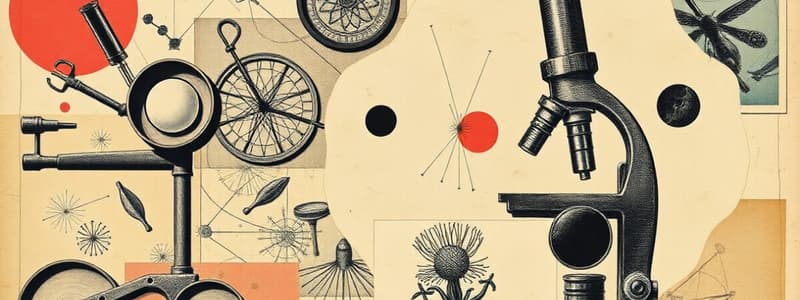Podcast
Questions and Answers
What units can you use for the graticule scale interval in biological drawings?
What units can you use for the graticule scale interval in biological drawings?
- 50µm
- 25/10/2.5µm (correct)
- 100µm
- 1µm
When making a biological drawing, shading is encouraged to add depth.
When making a biological drawing, shading is encouraged to add depth.
False (B)
What is the formula for magnification in biological drawings?
What is the formula for magnification in biological drawings?
Image size / Actual size
To ensure clarity, the lines of the biological drawing must be __________.
To ensure clarity, the lines of the biological drawing must be __________.
Match the following microscope parts with their functions:
Match the following microscope parts with their functions:
Which of the following is NOT a rule for using a microscope?
Which of the following is NOT a rule for using a microscope?
Labeling lines in a biological drawing should cross each other.
Labeling lines in a biological drawing should cross each other.
Name one type of cell that can be viewed under a light microscope.
Name one type of cell that can be viewed under a light microscope.
What is the primary function of the eyepiece (ocular) lens in a microscope?
What is the primary function of the eyepiece (ocular) lens in a microscope?
What is the magnification of the eyepiece lens in the microscope?
What is the magnification of the eyepiece lens in the microscope?
The objective lens has only one strength for magnifying images.
The objective lens has only one strength for magnifying images.
What unit of measurement is typically used to describe the actual size of a specimen in microscopy?
What unit of measurement is typically used to describe the actual size of a specimen in microscopy?
The actual size of the specimen can be calculated using the formula: Actual Size (mm/µm) = Image Size (mm/µm) / Magnification.
The actual size of the specimen can be calculated using the formula: Actual Size (mm/µm) = Image Size (mm/µm) / Magnification.
The _______ controls the amount of light entering the microscope slide.
The _______ controls the amount of light entering the microscope slide.
If an image is 1.5 mm long and drawn at a magnification of 100, what would be the work formula to find the actual size?
If an image is 1.5 mm long and drawn at a magnification of 100, what would be the work formula to find the actual size?
The actual size of an object viewed at 40X with a width of 24 eyepiece graticule intervals can be calculated using the formula: Actual Size = number of divisions on eyepiece graticule x _________.
The actual size of an object viewed at 40X with a width of 24 eyepiece graticule intervals can be calculated using the formula: Actual Size = number of divisions on eyepiece graticule x _________.
If a microscope has an eyepiece lens of 10X magnification and an objective lens of 40X, what is the total magnification?
If a microscope has an eyepiece lens of 10X magnification and an objective lens of 40X, what is the total magnification?
Match the following objective lenses with their total magnifications:
Match the following objective lenses with their total magnifications:
A fine focus knob is used to bring an image into rough focus.
A fine focus knob is used to bring an image into rough focus.
The total magnification formula is simply the product of the eyepiece and objective lens magnifications.
The total magnification formula is simply the product of the eyepiece and objective lens magnifications.
Convert 10.5 cm to micrometers (µm).
Convert 10.5 cm to micrometers (µm).
What is the interval of the graticule scale at a 10X objective lens?
What is the interval of the graticule scale at a 10X objective lens?
If a cell spans across 4 divisions with an objective lens of 40X, the actual size in _________ can be calculated using the scale interval.
If a cell spans across 4 divisions with an objective lens of 40X, the actual size in _________ can be calculated using the scale interval.
Flashcards
Eyepiece (ocular) lens
Eyepiece (ocular) lens
The lens closest to the eye, usually magnifying the image 10 times larger.
Objective lens
Objective lens
Different lenses with varying strengths for detailed viewing of the microscope slide.
Stage
Stage
The flat platform where the microscope slide is placed for observation.
Diaphragm
Diaphragm
Signup and view all the flashcards
Light
Light
Signup and view all the flashcards
Base
Base
Signup and view all the flashcards
Arm
Arm
Signup and view all the flashcards
Coarse focus knob
Coarse focus knob
Signup and view all the flashcards
Fine focus knob
Fine focus knob
Signup and view all the flashcards
Inverted image
Inverted image
Signup and view all the flashcards
Refraction
Refraction
Signup and view all the flashcards
Focal point
Focal point
Signup and view all the flashcards
Magnification
Magnification
Signup and view all the flashcards
Total magnification
Total magnification
Signup and view all the flashcards
Actual size
Actual size
Signup and view all the flashcards
Biological drawing scale
Biological drawing scale
Signup and view all the flashcards
Biological drawing
Biological drawing
Signup and view all the flashcards
What is a graticule?
What is a graticule?
Signup and view all the flashcards
What is the graticule interval?
What is the graticule interval?
Signup and view all the flashcards
How to calculate actual size?
How to calculate actual size?
Signup and view all the flashcards
What is the graticule interval at 4X?
What is the graticule interval at 4X?
Signup and view all the flashcards
What is the graticule interval at 10X?
What is the graticule interval at 10X?
Signup and view all the flashcards
What is the graticule interval at 40X?
What is the graticule interval at 40X?
Signup and view all the flashcards
How to calculate actual size using graticule?
How to calculate actual size using graticule?
Signup and view all the flashcards
How to calculate magnification of a drawing?
How to calculate magnification of a drawing?
Signup and view all the flashcards
Rules of Biological Drawing
Rules of Biological Drawing
Signup and view all the flashcards
Labeling in Biological Drawings
Labeling in Biological Drawings
Signup and view all the flashcards
Preparing a Specimen
Preparing a Specimen
Signup and view all the flashcards
Using the Microscope
Using the Microscope
Signup and view all the flashcards
Study Notes
Microscopes: Copy & Cells
- Microscopes are used to view tiny specimens that are not visible to the naked eye.
- The course will cover parts of microscope, magnification, specimen size, and biological drawing techniques.
What Will Be Learned
- Parts and functions of a microscope
- Total magnification and actual size of specimens
- Biological drawing techniques (magnification)
Parts & Table of Contents
-
Parts of a Microscope:
- Objective lens
- Ocular lens (eyepiece)
-
Biological Drawings:
- Learning to accurately draw the specimen
- Labeling the parts of the specimen
-
Functions of the microscope parts:
- Eyepiece (ocular) lens: Magnifies the image. Typically 10x.
- Objective lens: Different magnification lenses (e.g., 4x, 10x, 40x)
- Stage: Area where the slide is placed
- Diaphragm: Controls light
- Light: Illuminates the specimen
- Base: Keeps the microscope steady
- Arm: Supports the eyepiece
- Coarse focus knob: Used for initial focusing
- Fine focus knob: Used for precise focusing
How a Microscope Works
- The lens is convex.
- Light is bent and converges at a focal point.
- Beyond the focal point, the rays spread out again (magnifying the image).
- An inverted image is formed.
Looking Through a Microscope
- The specimen is placed on the stage.
- The image is viewed through the eyepiece.
- The objective lens magnifies the image.
- Different objective lenses provide varying magnifications (e.g., 4x, 10x, 40x).
Calculations
- The total magnification is the product of eyepiece magnification and objective lens magnification.
Conversions
- 10.5 cm is equal to 10,500 micrometers (µm).
Total Magnification
- Formula: Total magnification = magnification of eyepiece lens × magnification of objective lens
Magnification of Objective Lens
- To find the magnification of objective lens: use the formula Total magnification = Eyepiece magnification × Objective magnification
Actual Size Calculation
- Calculation: Actual size of specimen = Image size / magnification
Practicing
- Calculate specimens of known sizes (e.g., 1.5 mm long image magnified 100x).
Ocular Scale (Graticule)
- For precise measurements
- Scale printed onto the eyepiece of the microscope.
- Units are typically in millimeters (mm).
- Ocular scale is used with calculation: Actual size = number of divisions on graticule × graticule scale interval
Specimen Measurements
- A table of magnification and intervals and the relationship to the specimen (e.g., 4x, 40X, and 25μm)
- 1000μm = 1mm
Practice – Image Measurement
- Measure the size of a specimen in micrometers (µm).
Biological Drawings
-
Use blank paper. Drawings should be large (greater than 5cm)
-
Use only pencil
-
Label lines horizontally, and to right of diagram
-
No arrowheads
-
Underlined title below diagram
-
Calculations go below diagram area
-
Stippling to indicate shading if required
-
Examples of correct and incorrect biological drawing techniques.
Identifying Microscope Parts for Drawing
- Correct labeling of microscope parts for accurate drawings.
Preparing Specimens
- How to prepare a wet mount:
- Place the specimen on a slide.
- Add a drop of water or another liquid.
- Carefully place a cover slip on top.
Specimen Parts
- Cell membrane: outer edge/layer
- Cytoplasm: inside the cell, fluid-like substance
- Nucleus: dense structure within the cell
- Cell wall: outer layer of plant cells (typically seen in an onion or leaf cell)
- Chloroplast: green parts in a plant cell
Microscope Rules and Procedures
- Using the microscope safely
- Powering on and off the microscope
- Finding the specimen
- Using the coarse and fine focus
- Preparation and storage
Studying That Suits You
Use AI to generate personalized quizzes and flashcards to suit your learning preferences.




